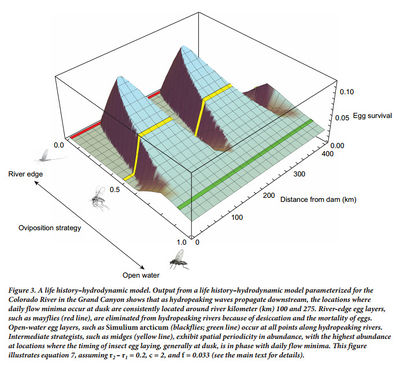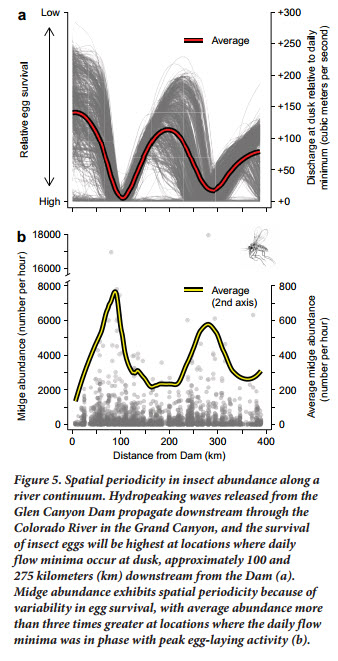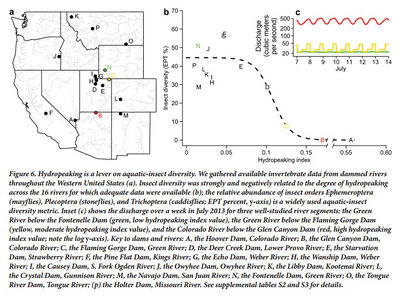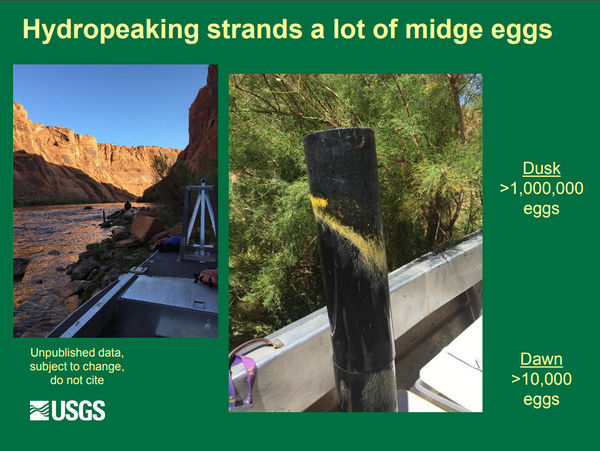Updates
|
|
Aquatic insects exhibit complex life cycles that include egg, larval, adult, and, in some instances, pupal
stages. Disturbances at any of these life stages can affect overall population dynamics. Yet, efforts to understand
the effects of disturbances, such as hydrologic alterations, overwhelmingly focus on the larval life stage of aquatic
insects. We evaluated the potential for load-following flows associated with hydroelectric power production to act
as a population bottleneck for aquatic insects via reductions in the availability and temporal persistence of optimal
oviposition habitats. Specifically, we quantified the oviposition habitat selectivity of Baetis spp. (Baetidae), Brachycentrus occidentalis (Brachycentridae), Chironomidae (Diptera), and Hydropsyche occidentalis (Hydropsychidae) downstream of Flaming Gorge Dam, Utah, USA. We found that all taxa except H. occidentalis preferentially laid
eggs on large emergent substrates located along the river edge. Peak discharge associated with load-following flows
substantially reduced the number of emergent substrates available for oviposition, and daily low flows exposed eggs
in these habitats to desiccation and drying. When subjected to experimental drying, both Baetis and H. occidentalis
eggs experienced nearly 100% mortality after 2 h, whereas most B. occidentalis remained viable after 8 h. Our paired
field and experimental results are consistent with the hypothesis that load-following flows from hydroelectric dams
produce a population bottleneck for aquatic insects by short circuiting recruitment processes. Environmental flows
that seek to improve the health of tailwater aquatic insect populations would benefit from consideration of habitat
requirements for all life stages of aquatic insects. [1]
|
|
Links and Information
|
|
|
Papers and Presentations
|
|
2020
2016
|
Other Stuff
|
- Caddis hatch below Parker Dam. There are several species of EPT below Parker and Davis Dam in spite of daily fluctuations that exceed 6 feet per day.
At least three genera of caddisflies and one genus of mayfly were collected in drift and benthic samples downstream of Davis and Parker Dams. These are species of a net-spinning caddisfly in the family Hydropsychidae (Smicridea), a case-building caddisfly in the family Leptoceridae (Nectopsyche), microcaddisflies in the family Hydroptilidae, and a swimming mayfly in the family Baetidae (Baetis). Hydroptilidae are found in light trap samples downstream of Lees Ferry in Grand Canyon, and are common in Arizona streans and rivers (Blinn and Ruiter, 2009). They are nonetheless very small (as indicated by its common name): at under 5 mm in total length (Merritt and others, 2008), generally smaller even than midge (Chironomidae) larvae, and therefore not a valuable prey item for fish. The genus Smicridea spins silk nets for capturing floating particles or organic matter suspended in the water column. For this reason, its family, in general, is common in tailwaters, where they can achieve great densities (Nakano and Strayer, 2014). In fact, Smicridea specifically is a documented pest species in the Parker Dam tailwater and in the Central Arizona Project canals carrying water to the Phoenix metropolitan area (D. Ruiter, personal communication). Baetis mayflies are one of the more common genera in aquatic ecosystems (Merritt and others, 2008); like midges, they are virtually ubiquitous in freshwater habitats. Relatively less information is currently available about the Nectopsyche caddisflies found in these sites, pending further literature research. (2016 GCMRC trip summary to WAPA)
|
|






